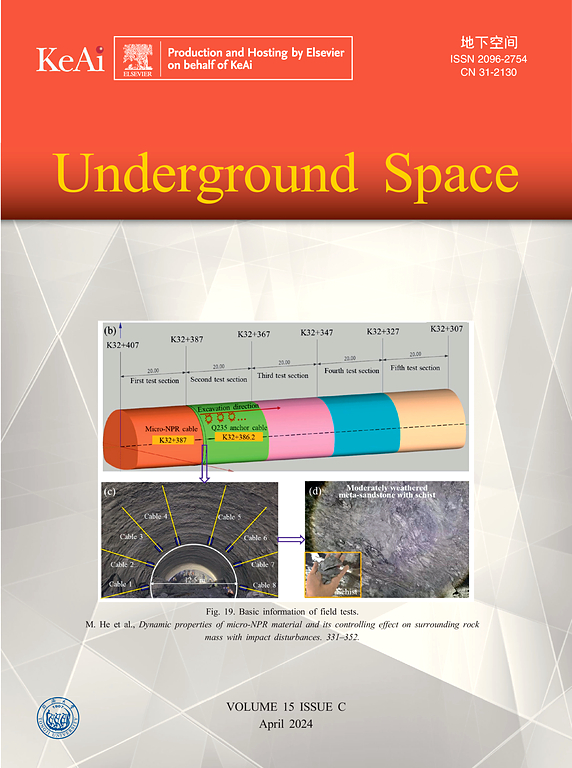基于改进粒子群算法和极限学习机的稀疏测量方法预测开挖引起的侧向位移
IF 8.3
1区 工程技术
Q1 ENGINEERING, CIVIL
引用次数: 0
摘要
深基坑工程的侧向位移监测对结构的稳定和安全至关重要。传统的测量方法,比如手动测斜仪,虽然很精确,但成本高昂,而且需要耗费大量人力。自动化系统提供实时数据,但面临传感器密集和成本高的挑战。提出了一种基于改进粒子群优化算法的极限学习机(ELM)预测方法。IPSO-ELM方法利用稀疏的自动测量来准确预测横向位移剖面,最大限度地减少了对密集传感器部署的需求。以杭州某30.2 m深基坑工程为例,验证了该方法的有效性。结果表明,IPSO-ELM模型即使在传感器位置稀疏的情况下也能保持较高的预测精度,具有较低的均方根误差(RMSE)和平均绝对误差(MAE)值。在整个测试数据集中,在传感器间距为5.0 m的情况下,该模型的最大RMSE值为0.94 ~ 2.79 mm,最大MAE值为0.77 ~ 2.18 mm,显示了其在预测侧向位移方面的鲁棒性和可靠性。详细讨论了实现该方法时不同传感器间距所带来的误差。这项研究强调了IPSO-ELM在日益复杂的城市开挖工程中作为一种具有成本效益和可靠的自动监测工具的潜力。本文章由计算机程序翻译,如有差异,请以英文原文为准。
Predicting excavation-induced lateral displacement using improved particle swarm optimization and extreme learning machine with sparse measurements
Monitoring lateral displacement in deep excavation projects is crucial for structural stability and safety. Traditional methods, like manual inclinometers, are accurate but costly and labor-intensive. Automated systems provide real-time data but face challenges with dense sensor placement and high costs. This study presents a novel prediction method using an extreme learning machine (ELM) optimized by an improved particle swarm optimization (IPSO) algorithm. The IPSO-ELM approach utilizes sparse automated measurements to accurately predict lateral displacement profiles, minimizing the need for dense sensor deployment. A case study of a 30.2-m-deep excavation project in Hangzhou, China, demonstrates the method’s effectiveness. The results demonstrate that the IPSO-ELM model maintains high prediction accuracy, with low root mean square error (RMSE) and mean absolute error (MAE) values, even under conditions of sparse sensor placement. Across the entire test dataset, with a sensor spacing of 5.0 m, the model achieved maximum RMSE values ranging from 0.94 to 2.79 mm and maximum MAE values ranging from 0.77 to 2.18 mm, thereby showcasing its robustness and reliability in predicting lateral displacement. A detailed discussion was conducted on the errors associated with various sensor spacing intervals when implementing the proposed method. This study underscores the potential of IPSO-ELM as a cost-effective and reliable tool for automatic monitoring in increasingly complex urban excavation projects.
求助全文
通过发布文献求助,成功后即可免费获取论文全文。
去求助
来源期刊

Underground Space
ENGINEERING, CIVIL-
CiteScore
10.20
自引率
14.10%
发文量
71
审稿时长
63 days
期刊介绍:
Underground Space is an open access international journal without article processing charges (APC) committed to serving as a scientific forum for researchers and practitioners in the field of underground engineering. The journal welcomes manuscripts that deal with original theories, methods, technologies, and important applications throughout the life-cycle of underground projects, including planning, design, operation and maintenance, disaster prevention, and demolition. The journal is particularly interested in manuscripts related to the latest development of smart underground engineering from the perspectives of resilience, resources saving, environmental friendliness, humanity, and artificial intelligence. The manuscripts are expected to have significant innovation and potential impact in the field of underground engineering, and should have clear association with or application in underground projects.
 求助内容:
求助内容: 应助结果提醒方式:
应助结果提醒方式:


